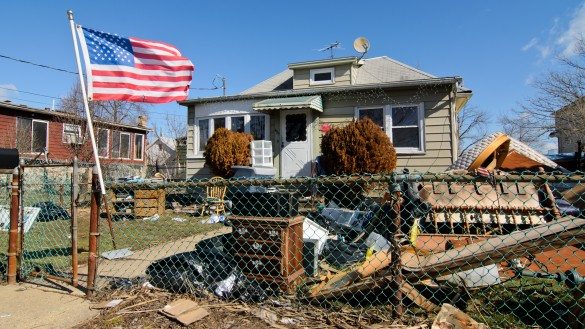City Lacks Funds To Fulfill “Build It Back,” Annoyed At Fed For Slow Distribution Of Money

The city announced that it might not have enough money to cover all the 24,000 applicants of the “Build it Back” program, leaving officials scrambling for solutions to address the needs of thousands of homeowners devastated by Superstorm Sandy. The Wall Street Journal is reporting that the city is approximately $1.9 billion short on funds.
Currently, the city has $648 million to spend on housing repairs while it is estimated that $2.6 billion will be needed to cover all the homeowners that have applied for assistance. The Journal described the breakdown of the federal money allocated to the city and addressed the fears of officials in coming up with the extra cash:
So far, the city has been given about $1.8 billion in federal grants from the Department of Housing and Urban Development, which pays for the program. It decided to spend the $648 million on housing, about $700 million on resiliency measures and about $300 million on grants to stricken businesses.
With $648 million, the “Build it Back” program can rebuild about 4,000 homes for lower-income people and wouldn’t be able to reimburse for repairs already made, according to the city’s rebuilding office.
“We don’t know how much money we are going to get. We got $1.8 billion. We know that’s not going to cover everybody or even going to be close,” said Cas Holloway, a deputy mayor.
Mr. Holloway and state officials said they expected further allocations from the federal government but weren’t certain of the timing or the amount. A spokeswoman for Housing and Urban Development didn’t respond to a request for comment.
City officials expressed increased frustration with the slow pace of Washington when it comes to distributing the necessary funds. Officials blamed the red tape of Washington for the turtle-like pace of aid distribution and already noted its consequences:
New York officials said federal rules, some implemented after Katrina, have required them to perform lengthy tasks, such as conducting environmental reviews on every home that must be repaired and determining whether rebuilding work is happening on Native American burial grounds…
The slow pace of distributing the portion of the money meant for housing has had widespread effects, New York officials said. Many who lost their homes during the storm have lived for months in hotels at government expense, stayed in cramped quarters with family and friends, paid rent on apartments while falling behind on mortgage payments or lived in homes without kitchens or other amenities.
Some said they had all but given up on getting help.
“Do I have any faith in it? Not really,” Nicole Chati, a resident of New Dorp Beach on Staten Island, said of city programs to help her rebuilding her home. “I’ve gone through so much of, ‘We’re going to help, we’re going to help,’ and it’s just not there.”
Brad Gair, the city’s housing recovery director, blamed the system for holdups.
“It’s very, very difficult to get this money. It’s very hard to explain to people. It’s very hard to keep their trust in a process like this,” Gair told the Journal. “We’ve got to fix this system.”
To date, only one homeowner, a Staten Island resident, has received funds through Build it Back’s acquisition program.




